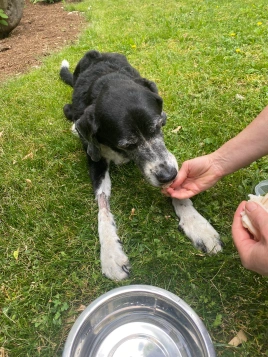In order to create a deep connection with our canine companions, it is crucial to foster trust as a foundation. Building this trust involves various actions such as calling their names, providing gentle pats, and offering treats, all of which play a significant role in establishing a affectionate and secure bond.
For instance, something as simple as holding a piece of kibble on the edge of your fingertips can be an effective approach to encouraging your dog to eat at a more relaxed pace or as a way to reward their good behavior.
Nevertheless, there are instances when dogs decline to eat from their designated bowls and solely prefer food offered by their human companions.
Why dogs want to be hand fed. This behavior of wanting to be hand fed often perplexes pet parents, particularly when it arises abruptly. We consulted veterinarians to shed light on the possible reasons behind this behavior.
Why Dogs Want to Be Hand Fed
Separation anxiety can serve as a potential indicator of why your dog prefers to be hand fed, and this condition can be influenced by various contributing factors. For example, if your furry friend is a rescue and specific triggers cause distress, they may seek comfort through being hand fed.
Alternatively, if your canine companion dislikes being alone at home, they might seek increased direct attention from you before you depart for work or upon your return.
Here are additional possible explanations as to why your pup may prefer to receive food from your hand:
Illness
Occasionally, when dogs are feeling unwell, providing them with small amounts of a bland diet through hand-feeding ensures they receive some nourishment.
Other Dogs
In households with multiple hungry pups, mealtime chaos can occur, resulting in some dogs not getting enough food from the communal bowls. Hand-feeding can help ensure each dog receives their fair share.
Human Conditioning
Your dog may have developed a preference for hand-feeding due to conditioned behavior. This could have originated when they were sick or exhibiting picky eating, during a transition to a new type of dog food, or as a result of their previous situation, such as being in a shelter, with a foster family, or under a previous owner or breeder who practiced hand-feeding.
They’re Distracted
Dogs that are highly vigilant and constantly monitoring their surroundings may be too preoccupied to take the time to eat from a bowl, opting for hand-feeding instead.
Trauma
If a negative event occurred near the food bowl, your dog may associate eating from a bowl with that unpleasant experience. Similarly, if they were frightened by another dog or a loud noise during mealtime, that fear may persist and make them hesitant to eat from a bowl.
Is Hand Feeding Dogs Problematic?
It’s important to note that positive reinforcement trainers often utilize hand feeding treats as a valuable tool for teaching dogs vital skills and new tricks.
However, its benefits extend beyond that. Hand feeding can aid in developing impulse control, mitigating resource guarding (which occurs when a dog becomes defensive about sharing their belongings), and fostering trust in fearful or shy dogs.
it may not always be feasible to hand feed a dog on a regular basis. If your dog refuses to eat from their bowl without any apparent reason, it is crucial to schedule a veterinary exam to investigate and eliminate any potential underlying medical issues.
Interested in Dog Feeding. Read our blog on Best Protein Sources for Dogs.
Sources: Hand Feeding Your Dog It’s Dinner

